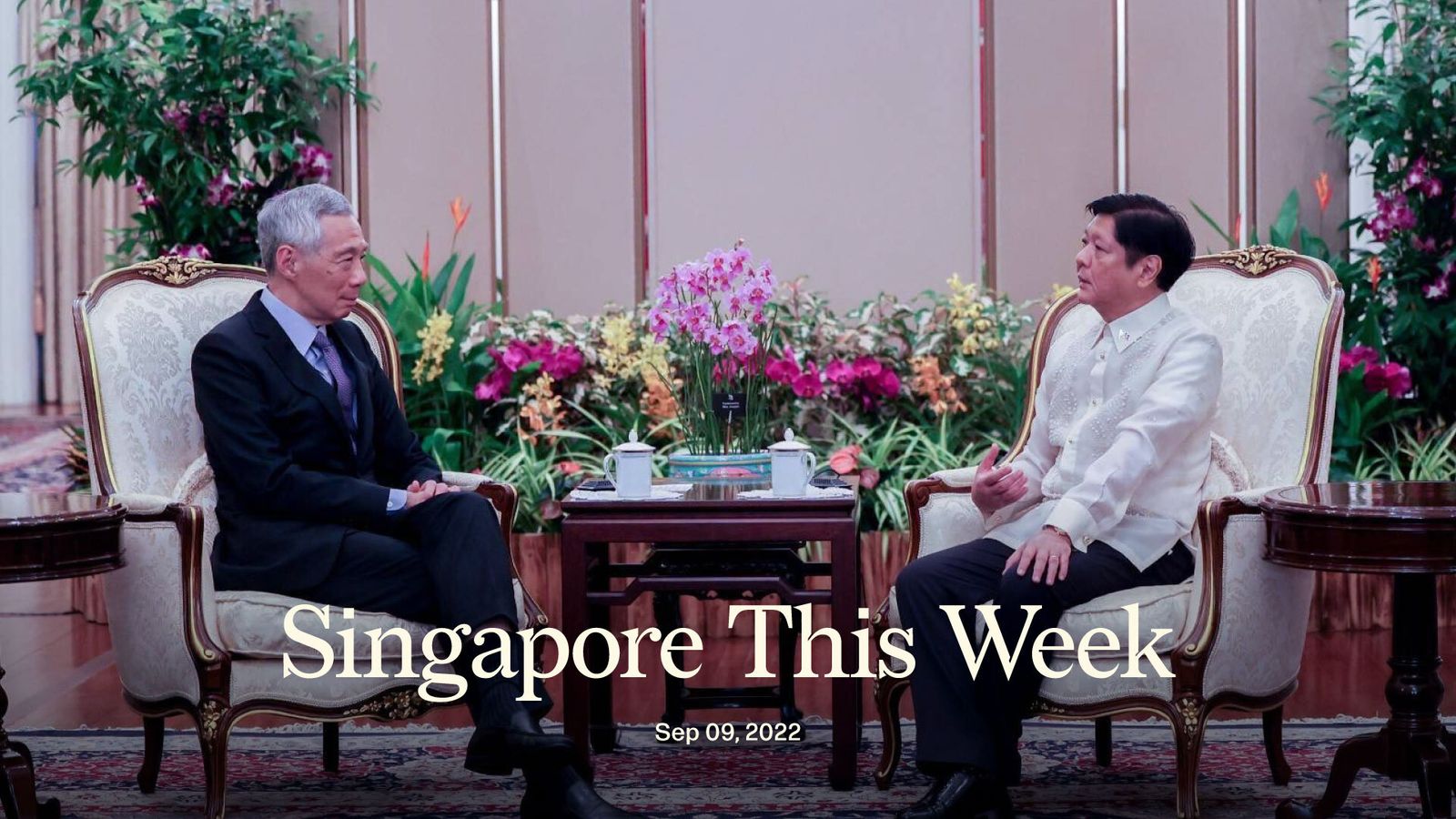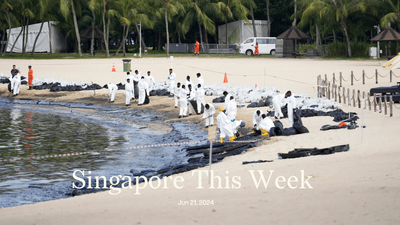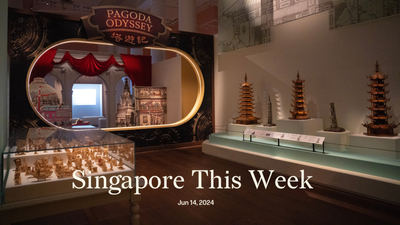Politics: All hail the strongson
As part of an official state visit, Ferdinand “Bongbong” Marcos Jr, the Philippines president, was given a raucous welcome by about 2,000 Singapore-based Filipinos. Some 215,000 Filipinos work here, including about 81,000 domestic workers. Perhaps wanting their own Lee Kuan Yew, Filipinos in Singapore have long taken a kind view to strongmen leaders, including Marcos’s predecessor, Rodrigo Duterte. In the recent election, Marcos Jr won about 68 percent of the overseas Singapore vote, compared to 58 percent overall. Social media propaganda and sanitised textbooks have helped Filipinos forget the horrors of Marcos’s father’s brutal kleptocracy. Marcos Jr and his technocrats hope to improve domestic security and employment prospects, so as to lure Filipinos home. If he eventually succumbs to patronage and nepotism, Singapore may not mind. “Filipino professionals whom we recruited to work in Singapore are as good as our own,” Lee once said. “Indeed, their architects, artists, and musicians are more artistic and creative than ours.” The irony is that while the late Marcos looted cash, Lee, local artists might say, robbed Singapore of creativity.
Society: Net zero
Singapore finally committed to reducing emissions to net zero by 2050, bringing it in line with most other countries. A year ago, when Singapore’s net-zero target was “as soon as viable in the second half of the century”, international climate researchers called it “critically insufficient”, and plonked Singapore alongside the likes of Iran and Russia. Cross-country comparison in any domain is tricky because Singapore is the world’s only global city cum sovereign state. Environmentally, our high population density, lack of land, and lack of easy renewable sources have complicated the journey to net zero. Yet now, prompted by youth activism, Singapore is more likely to make climate proclamations than excuses. In 2019, it was the first South-east Asian country to introduce a carbon tax, and it has now set aggressive targets: from the current S$5 per tonne of emissions to between S$50 and S$80 by 2030. (The Carbon Price Leadership Coalition recommends US$50-US$100 by 2030.) Let’s hope that national targets and market mechanisms work in concert with individual action—waste reduction, lower consumption—to bring about the greener Singapore and world that we want.
Society: Making workplaces inclusive to neurodiversity
More companies are hiring persons with disabilities (PWD), largely because of corporate social responsibility initiatives and the broader manpower shortage, according to SG Enable, an agency under the Ministry of Social and Family Development. Singapore aims to raise the share of employed, working-aged PWDs from 30 to 40 percent by 2030, which will place an estimated 10,000 more PWDs into the workforce. For those with autism spectrum disorder (ASD), there is a misconception that they can only do repetitive tasks, and find it hard to fit in, due to social awkwardness and difficulty in communicating. But they have performed well in various industries, including tech and healthcare—since they’re often meticulous, focussed, and deliver high-quality output. While corporate hiring policies are increasingly diverse and inclusive, more could be done to make job ads and interviews accessible. In the workplace, companies should strive to adapt existing processes so they’re sensitive to neurodiversity, and educate staff on being more empathetic to differences in social and cognitive behaviours.
Arts: Upstaging Lee
Local theatre has the reputation of being an anti-establishment art form. Yet on occasion it celebrates the creation of that very establishment. Returning to the Sands Theatre after its immensely successful run in 2015 is The LKY Musical. There are new songs, new musical arrangements, and a new key cast member: veteran actress Kit Chan replaces Sharon Au in the role of Lee’s wife, Kwa Geok Choo. The 2015 run, in the year that Lee Kuan Yew died and Singapore celebrated its 50th year of independence, was criticised for its overly sanitised portrayal of the man who did not hesitate to detain political opponents, and who openly espoused eugenicist views. Seven years on, more Singaporeans are eager for an honest assessment of Lee’s legacy. Will the Singapore Repertory Theatre provide any new nuance to the hero’s myth? Probably not, but if it does, it could add critical acclaim to the expected commercial.
Arts: Ever present
It’s your last chance to catch Ever Present, an exhibition of Aboriginal and Torres Strait Islander art at the National Gallery Singapore. The exhibition is on tour from the National Gallery of Australia and features work from more than 80 First Nations artists. This is the largest exhibition of Aboriginal and Torres Strait Islander art to ever be shown outside of Australia, providing museum visitors with a rare opportunity to experience the rich artistic practices of the world’s oldest continuous culture. It also illuminates the First Peoples of Australia’s long history of trade relations and sea travel through Southeast Asian connections like batik styles developed in Central Australia through direct collaborations with artists from Indonesia. The show is now free and runs until 25th September.
Internet culture: Manufactured creativity
K Shanmugam, home affairs and law minister, might be the latest politician to join TikTok but the most popular is definitely Lawrence Wong, likely next prime minister. A recent video of Wong dancing along to POP! by K-pop star Nayeon (at the G20 in Bali, no less) garnered over 24,000 likes. Still, videos on actual policies, like the S$1.5bn support measures package announced in June, receive under 10,000 likes, low by TikTok standards. Politicians, with their meticulously managed public personas, will not easily succeed on a platform that thrives on irreverence and spontaneity. The ruling People’s Action Party hopes it will help them score points with the young, the group seemingly most disenchanted with it.
@lawrencewongst Full day at G20 in #Bali ♬ 오리지널 사운드 - M2
History weekly by Faris Joraimi
This week Lawrence Wong told Ismail Sabri, Malaysia’s prime minister, that Singapore is open to reviving the High-Speed Rail project linking us with KL. If completed, we can once again enjoy an uninterrupted rail link between the two capitals. Today you have to change trains twice before reaching KL Sentral. Rail projects are often bedevilled by politics. In the late 1800s, work on the old Federated Malay States Railways (FMSR) was delayed when Johor, then still independent, refused to allow the extension of tracks into its territory. Frank Swettenham, resident-general of the Federated Malay states, led the push for the integration of Malaya’s separate state railways into one transpeninsular line. The British believed it would boost the transport of tin and rubber to international markets through Singapore. Johor feared—and rightly so—that this tentacle of British power would strangle their sovereignty. The death in 1895 of Sultan Abu Bakar, Johor’s astute leader, left the state in a weakened position. His son Ibrahim signed an amalgamation agreement in 1904, with the line completed by 1909. It bolstered the imperial plan for “a continuous line of permanent way” from Singapore to the English Channel, and represented “the opening up of the tropics to modern civilisation.” As historical irony would have it, the railways brought Malayans closer together and helped build a shared identity. “FMSR”, on the façade of the Tanjong Pagar Railway Station—a gazetted National Monument—is a reminder of that.
Tech: Every student is a good technologist
A new TechSkills Accelerator for ITE and Polytechnics (TIP) Alliance, comprising 12 companies such as Google, Singtel and DBS, will offer vocational training to tertiary students in the form of internships and apprenticeships. The government’s desire to broaden the supply of young tech workers comes on top of other initiatives to bolster local and foreign talent, including the new ONE Pass for industry stars. In 2021, Singapore had more than 19,000 unfilled jobs in the ICT sector. There is also an element of inclusiveness and academic egalitarianism to this latest effort. Students at polytechnics and ITEs (Institute of Technical Education) have sometimes been caricatured as the poorer cousins of those in junior colleges and universities, even though the former often outperform in the workplace. Heng Swee Keat, deputy prime minister, hopes that “this initiative will contribute to the shift from qualification- to skills-based hiring practices, giving capable job seekers equal opportunity to succeed, regardless of their starting point or educational background.”
Tech: Layoff season
Even as some tech firms struggle to find workers, others are cutting back. Foodpanda, a Singapore-headquartered food delivery firm, laid off some 60 employees in Singapore as its parent company, Delivery Hero, seeks to achieve profitability through cost cutting. Foodpanda only just spruced up a swanky, new, pink-hued regional HQ to house its 1,200 employees in Singapore. The regional HQ also serves as the global tech hub to pilot innovations such as the cloud store network pandamart, on-demand retail marketplace Foodpanda shops, and proof-of-concept drone deliveries in partnership with ST Engineering. Foodpanda is not alone in this layoff season as e-commerce company Shopee also recently announced that it had to rescind several offers for new employees who had just moved to Singapore to start work.
If you enjoy Jom’s work, do get a paid subscription today to support independent journalism in Singapore.







